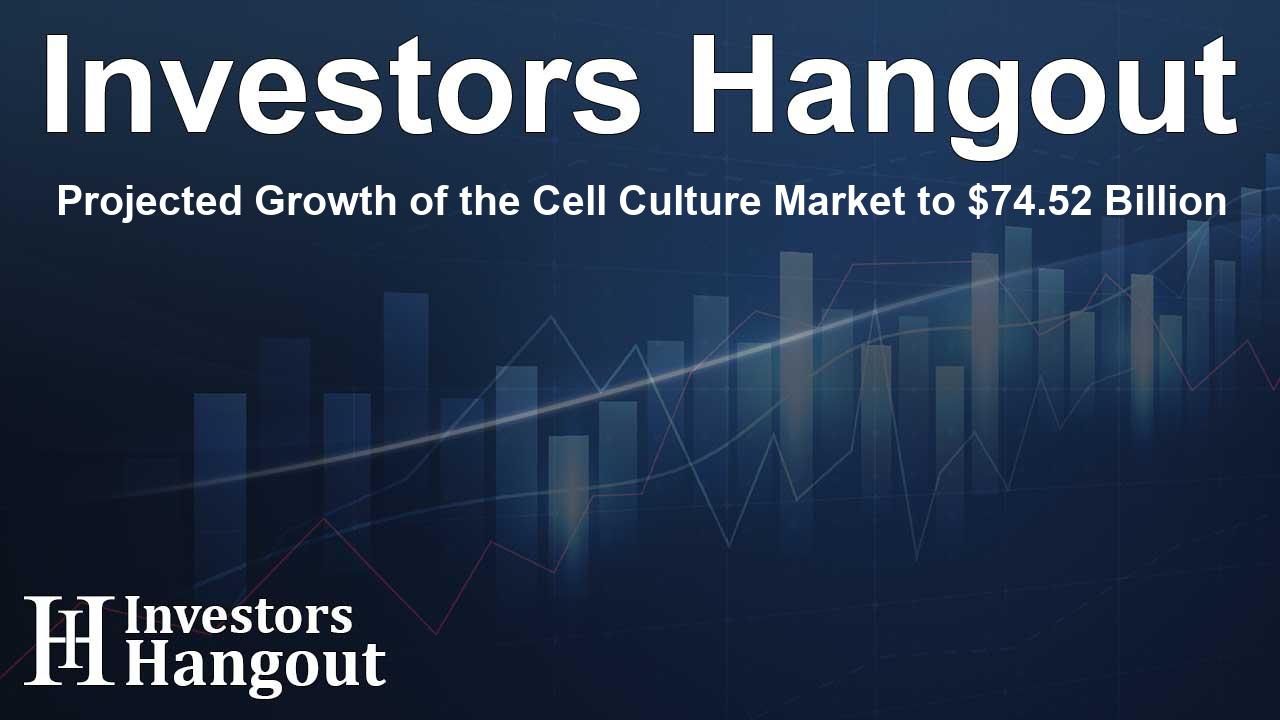Projected Growth of the Cell Culture Market to $74.52 Billion

The Expanding Horizon of the Global Cell Culture Market
The cell culture market is on the rise, with projections indicating it could attain a staggering valuation of USD 74.52 billion by the year 2031. This growth trajectory represents a compound annual growth rate (CAGR) of 13.4% from 2024 to 2031. The market's growth is attributed to several factors, including the increasing utilization of cell culture techniques, particularly for supportive measures in the manufacturing of viral vaccines. As more organizations adopt innovative cell culture methods, the demand for reliable and efficient production techniques continues to grow.
Unveiling the Drivers of Growth in Cell Culture Techniques
A significant driver of this market expansion is the recent interest in three-dimensional cell culture techniques, which are redefining the landscape of vaccine and biopharmaceutical production. The implications of the COVID-19 pandemic have further catalyzed interest in research capabilities associated with novel infectious diseases, underscoring the need for effective diagnostic and therapeutic measures. This has resulted in a broader appreciation for cell culture applications in medical science and biotechnology.
Market Overview
The cell culture market is diverse, with a wide array of applications including stem cell research, cancer studies, and regenerative medicine practices. As technology progresses, industries are investing heavily in research and development initiatives to enhance capabilities in these areas.
Breakdown of the Market Segments
The cell culture market is segmented into distinct categories such as application, end user, and product lines:
- Applications: This includes stem cell technology, cancer research, drug screening, and tissue engineering, among others.
- End Users: Comprising research institutions and pharmaceutical companies, this segment is crucial for driving the demand for cell culture technologies.
- Products: Ranging from consumables, media, and reagents to specialized equipment like bioreactors and culture vessels, this category underpins the operational aspects of cell culture.
Market Dynamics and Factors Fueling Growth
The consumables segment holds a commanding share of the market, having accounted for 57.44% in 2022. This can be largely attributed to ongoing investments in R&D aimed at developing complex biologics, such as monoclonal antibodies and vaccines. The growing complexity of biologics is driving a consistent need for consumables, including reagents and culture media.
Technological Advancements and Innovation in Diagnostics
One area undergoing rapid growth is the diagnostics segment, which is anticipated to grow at a remarkable CAGR of 14.29%. Increased utilization of cell culture techniques for metabolomics research is enhancing the ability to identify crucial disease biomarkers. Specifically, developments around cell culture metabolites are enhancing diagnostics and improving cancer surveillance methodologies.
The Regional Landscape of the Cell Culture Market
North America continues to dominate the global cell culture market with a 35.90% share in 2022. This prevalence can be linked to the region's robust biotech and pharmaceutical sectors, which are at the forefront of integrating cutting-edge technologies. Furthermore, increasing initiatives for research tied to various health concerns ensure a sizeable market presence for cell culture technologies.
Conversely, the Asia-Pacific region is expected to experience the highest growth rate, projected at a CAGR of 13.79%. This is attributed to burgeoning clinical research opportunities and an escalating focus on cell and gene therapies, alongside proactive healthcare expenditure.
Challenges Facing the Cell Culture Industry
While opportunities abound, the cell culture sector faces challenges, including:
- Scarcity of skilled professionals in the field.
- Regulatory hurdles that can complicate innovation.
- High initial costs associated with cell culture technologies.
The Future of the Cell Culture Market
Significant players in the industry, such as Thermo Fisher Scientific and Danaher Corporation, are actively engaged in research and innovation that will shape the future of the market. As the landscape becomes increasingly competitive, understanding market dynamics will be critical for stakeholders aiming to leverage opportunities effectively.
Frequently Asked Questions
What is the projected growth rate for the cell culture market?
The cell culture market is projected to grow at a CAGR of 13.4% from 2024 to 2031.
What are the key applications of cell culture?
Key applications include stem cell research, drug screening, tissue engineering, and regenerative medicine.
Which regions are leading in cell culture market growth?
North America currently leads in market share, with Asia-Pacific expected to grow at the highest rate.
What challenges does the cell culture market face?
The market faces challenges such as labor shortages, regulatory issues, and high equipment costs.
Who are the major players in the cell culture market?
Prominent companies include Thermo Fisher Scientific, Danaher Corporation, and Merck KGaA among others.
About Investors Hangout
Investors Hangout is a leading online stock forum for financial discussion and learning, offering a wide range of free tools and resources. It draws in traders of all levels, who exchange market knowledge, investigate trading tactics, and keep an eye on industry developments in real time. Featuring financial articles, stock message boards, quotes, charts, company profiles, and live news updates. Through cooperative learning and a wealth of informational resources, it helps users from novices creating their first portfolios to experts honing their techniques. Join Investors Hangout today: https://investorshangout.com/
Disclaimer: The content of this article is solely for general informational purposes only; it does not represent legal, financial, or investment advice. Investors Hangout does not offer financial advice; the author is not a licensed financial advisor. Consult a qualified advisor before making any financial or investment decisions based on this article. The author's interpretation of publicly available data shapes the opinions presented here; as a result, they should not be taken as advice to purchase, sell, or hold any securities mentioned or any other investments. The author does not guarantee the accuracy, completeness, or timeliness of any material, providing it "as is." Information and market conditions may change; past performance is not indicative of future outcomes. If any of the material offered here is inaccurate, please contact us for corrections.